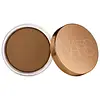What's inside
What's inside
 Key Ingredients
Key Ingredients

 Benefits
Benefits

 Concerns
Concerns

 Ingredients Side-by-side
Ingredients Side-by-side

Dimethicone
EmollientDipentaerythrityl Pentaisononanoate
EmollientTrisiloxane
Skin ConditioningSilica
AbrasivePolyethylene
AbrasiveDimethicone/Vinyl Dimethicone Crosspolymer
Skin ConditioningPolysilicone-11
Plumeria Alba Flower Extract
Skin ConditioningTrimethylsiloxysilicate
EmollientParfum
MaskingCocos Nucifera Oil
MaskingGardenia Taitensis Flower
Skin ConditioningPlumeria Rubra Flower Extract
Skin ConditioningTocopherol
AntioxidantBenzyl Salicylate
PerfumingHexyl Cinnamal
PerfumingLinalool
PerfumingIron Oxides
CI 77891
Cosmetic ColorantDimethicone, Dipentaerythrityl Pentaisononanoate, Trisiloxane, Silica, Polyethylene, Dimethicone/Vinyl Dimethicone Crosspolymer, Polysilicone-11, Plumeria Alba Flower Extract, Trimethylsiloxysilicate, Parfum, Cocos Nucifera Oil, Gardenia Taitensis Flower, Plumeria Rubra Flower Extract, Tocopherol, Benzyl Salicylate, Hexyl Cinnamal, Linalool, Iron Oxides, CI 77891
C15-19 Alkane
SolventJojoba Esters
EmollientRicinus Communis Seed Oil
MaskingTribehenin
EmollientColloidal Oatmeal
AbsorbentGlycerin
HumectantBeeswax
Emulsion StabilisingVitis Vinifera Seed Oil
EmollientHydrogenated Castor Oil
EmollientSilica
AbrasiveBentonite
AbsorbentSambucus Nigra Fruit Extract
AstringentCopernicia Cerifera Wax
Mica
Cosmetic ColorantParfum
MaskingCI 77891
Cosmetic ColorantIron Oxides
Tin Oxide
Abrasive
 Reviews
Reviews

Ingredients Explained
These ingredients are found in both products.
Ingredients higher up in an ingredient list are typically present in a larger amount.
Ci 77891 is a white pigment from Titanium dioxide. It is naturally found in minerals such as rutile and ilmenite.
It's main function is to add a white color to cosmetics. It can also be mixed with other colors to create different shades.
Ci 77891 is commonly found in sunscreens due to its ability to block UV rays.
Learn more about CI 77891Parfum is a catch-all term for an ingredient or more that is used to give a scent to products.
Also called "fragrance", this ingredient can be a blend of hundreds of chemicals or plant oils. This means every product with "fragrance" or "parfum" in the ingredients list is a different mixture.
For instance, Habanolide is a proprietary trade name for a specific aroma chemical. When used as a fragrance ingredient in cosmetics, most aroma chemicals fall under the broad labeling category of “FRAGRANCE” or “PARFUM” according to EU and US regulations.
The term 'parfum' or 'fragrance' is not regulated in many countries. In many cases, it is up to the brand to define this term.
For instance, many brands choose to label themselves as "fragrance-free" because they are not using synthetic fragrances. However, their products may still contain ingredients such as essential oils that are considered a fragrance by INCI standards.
One example is Calendula flower extract. Calendula is an essential oil that still imparts a scent or 'fragrance'.
Depending on the blend, the ingredients in the mixture can cause allergies and sensitivities on the skin. Some ingredients that are known EU allergens include linalool and citronellol.
Parfum can also be used to mask or cover an unpleasant scent.
The bottom line is: not all fragrances/parfum/ingredients are created equally. If you are worried about fragrances, we recommend taking a closer look at an ingredient. And of course, we always recommend speaking with a professional.
Learn more about ParfumSilica, also known as silicon dioxide, is a naturally occurring mineral. It is used as a fine, spherical, and porous powder in cosmetics.
Though it has exfoliant properties, the function of silica varies depending on the product.
The unique structure of silica enhances the spreadability and adds smoothness, making it a great texture enhancer.
It is also used as an active carrier, emulsifier, and mattifier due to its ability to absorb excess oil.
In some products, tiny microneedles called spicules are made from silica or hydrolyzed sponge. When you rub them in, they lightly polish away dead skin layers and enhance the penetration of active ingredients.
Learn more about SilicaThis ingredient is a combination of red, black, and yellow iron oxide pigments. This combination of colors is usually found in foundation, because it results in a "skin" color.